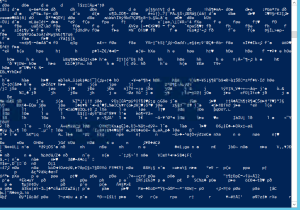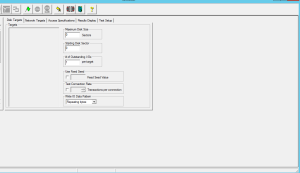Storage Testing With SQLIO and FIO
Recently I’ve been tasked with testing storage for a hardware purchase for a new, large SQL Server implementation. I’ve not gotten everything “down pat” as far as SQL Server IO methods, but I figured I’d take on the challenge of getting better.
SQLIO: The go-to tool
There are plenty of SQLIO resources on the Internet, but Jonathan Kehayias has a good post that uses SQLIO well and also references other posts. I set up my tests with a PowerShell script (incorporating Jonathan’s RegEx pattern matching) to run 1 to 64 threads (multiples of 2 only), with 1 to 128 outstanding IO requests (also multiples of 2), with 64KB and 512KB block sizes, both random and sequential on a Windows Server 2012 R2 server.
[code language=“powershell”] #RegEx matching courtesy of Jonathan Kehayias’ SQLIOResults PowerShell script, available:
http://sqlblog.com/blogs/jonathan_kehayias/archive/2010/05/25/parsing-sqlio-output-to-excel-charts-using-regex-in-powershell.aspx
$results = New-Object system.data.datatable;
$results.Columns.add(“Threads”); $results.Columns.add(“Operation”); $results.Columns.add(“IOSize”); $results.Columns.add(“IOType”); $results.Columns.Add(“PendingIO”); $results.Columns.Add(“IOPS”); $results.Columns.Add(“MB/s”); $results.Columns.Add(“Min_Latency_MS”); $results.Columns.Add(“Max_Latency_MS”); $results.Columns.Add(“Avg_Latency_MS”);
$max_threads = 64; $max_outstanding_requests = 128; $block_sizes = @(64,512); $duration = 30; $kind = @(“R”,“W”); $factr = @(“random”,“sequential”); #Set-Location C:\SQLIO;
#C:\SQLIO\sqlio.exe -FC:\SQLIO\param.txt -kW -t2 -s15 -dE -o1 -frandom -b64 -BH -LS
foreach ($ki in $kind)
{
$k = “-k$ki”;
foreach ($fa in $factr)
{
$f = "-f$fa";
foreach($block_size in $block_sizes)
{
$b = "-b$block_size";
$th = 2;
while ($th -le $max_threads)
{
$s = "-s$duration";
$t = "-t$th";
$or = 1;
while ($or -le $max_outstanding_requests)
{
$row = $results.NewRow();
$o = "-o$or";
#write-host "C:\SQLIO\sqlio.exe -BH -LS $s $k $f $b $t $o";
$r = E:\SQLIO\sqlio.exe -BH -LS $s $k $f $b $t $o \DB52\testfile.dat;
#$i = $r.Split("`n")[10].Split(":")[1].Trim()
$i = [decimal]([regex]::Match($r, "IOs\/sec\:\s+(\d+\.\d+)?").Groups[1].Value);
#$m = $r.Split("`n")[11].Split(":")[1].Trim()
$m = [decimal]([regex]::Match($r, "MBs\/sec\:\s+(\d+\.\d+)?").Groups[1].Value);
$min_latency = [int]([regex]::Match($r, "Min.{0,}?\:\s(\d+)?").Groups[1].Value)
$max_latency = [int]([regex]::Match($r, "Max.{0,}?\:\s(\d+)?").Groups[1].Value)
$avg_latency = [int]([regex]::Match($r, "Avg.{0,}?\:\s(\d+)?").Groups[1].Value)
"-o " + $or + ", threads: $th kind: $ki blocksize: $block_size $fa " + $i + " iops, " + $m + " MB/sec, " + $l + " ms" + $min_latency + " ms " + $max_latency + " ms " + $avg_latency + " ms";
$row["Threads"] = $th;
$row["Operation"] = $ki;
$row["IOSize"] = $block_size;
$row["IOType"] = $fa;
$row["PendingIO"] = $or;
$row["IOPS"] = $i;
$row["MB/s"] = $m;
$row["Min_Latency_MS"] = $min_latency;
$row["Max_Latency_MS"] = $max_latency;
$row["Avg_Latency_MS"] = $avg_latency;
$results.Rows.Add($row);
$or = $or * 2;
}
$th = $th * 2;
}
}
}}
$results | Export-Csv results.csv -notypeinformation [/code]
An odd thing happened along the way. I started receiving these errors with the 512KB reads and writes at thread counts over 16 and outstanding IOs of 128.
init_thread: VirtualAlloc (0x00800000 bytes for I/O Buffer): Not enough storage is available to process this command.
exiting
Apparently, I wasn’t the only one having these issues.
While searching for answers, James Lupolt (b|t) pointed me to some blog posts that highlighted the fact that SQLIO actually initializes files with 0x0 - which some have called “zero” but, as Grant Fritchey notes, is actually a “null” character.
[code language=“powershell”] Get-Content testfile.dat [/code]
confirms:

Many SANs will recognize, and compress, repeating characters and as a result, may artificially inflate your SAN’s performance (per the Delphix blog). This would be great if our data files had a large amount of data that could be compressed at the block level. Unfortunately, this doesn’t characterize our data files and, as such, we’re not benchmarking as accurately as we could.
IOMeter: Ehrmagerd
Evidently I don’t have the IQ to be able to handle IOMeter. I wanted multi-threaded access to files and I couldn’t figure it out. In fact, I agree with Brent Ozar wholeheartedly when he says:
I gotta be honest with you: Iometer isn’t the friendliest tool around. I think it makes SQLIO look easy.
FIO: A Challenger Appears
The Delphix blog referenced an interesting tool - FIO which was touted as a more flexible, platform-agnostic storage testing system. I will admit that it took a while to figure out how to make it run, but once I did I found it to be quite useful. I’ll spare you the gory details and just get to the part where I figured out how to make it work.
A parameter mapping between the SQLIO and FIO is possible, but not 1:1 so it may be easier to use an actual example of a hardware-buffered, random write, single-threaded, outstanding IO of 1, 90 second, 64KB blocksize test on a 50MB file called testfile.dat: ` –param.txt testfile.dat 2 0x0 50
–sqlio.exe test (after having expanded the file) sqlio.exe -BH -kW -frandom -t1 -o1 -s90 -b64 testfile.dat
– fio config (after creating a file) fio.exe –direct=1 -rw=randwrite -numjobs=1 –iodepth=1 –time_based=1 –runtime=30s –blocksize=64k –filename=testfile.dat –size=50m ` –direct appears to be a direct call to the hardware (which may, or may not be able to satisfy from cache and roughly equivalent to the -BH hardware buffering switch in SQLIO), whereas –buffered would be equivalent to the software buffering option in SQLIO.
There are also a number of other helpful switches for FIO, including –output which will let you specify the test result location, –ioengine (which engine to use), –group_reporting will report on the group results instead of the job results (so you can get how each thread performed if you’d like), and –loops will allow you to run the test multiple times.
Since the big issue was the null character values in the SQLIO test file, I wanted to make sure that we have actual data in the file:
My comparable FIO testing PowerShell script to the above SQLIO script looks something like this:
[code language=“powershell”] #threads #op type #duration #io size #pending io
$max_threads = 64;
$max_outstanding_requests = 128;
$block_sizes = @(64,512);
$duration = 30;
$rws = @(“read”,“randread”,“write”,“randwrite”);
#Set-Location \your\path\to\fio\here
.\fio.exe –size=50m –iodepth=1 –blocksize=8k –filename=50mtest.dat –name=build –thread;
foreach($rw in $rws)
{
$rw;
foreach($bs in $block_sizes)
{
$th = 1;
while($th -le $max_threads)
{
$iodepth = 1;
while ($iodepth -le $max_outstanding_requests)
{
$bl_size = “–blocksize=” + $bs + “k”;
write-host “–rw=$rw –size=50m –iodepth=$iodepth –direct=1 $bl_size –nrfiles=1 –numjobs=$th –group_reporting=1 –ioengine=windowsaio –loops=1 –time_based=1 –runtime=30s –thread –filename=50mtest.dat –name=test –output=G:\fio_tests\testrun_50mb-$rw-$bs-$th-$iodepth.txt”;
.\fio.exe –rw=$rw –size=50m –iodepth=$iodepth –direct=1 $bl_size –nrfiles=1 –numjobs=$th –group_reporting=1 –ioengine=windowsaio –loops=1 –time_based=1 –runtime=30s –thread –filename=50mtest.dat –name=test –output=G:\fio_tests\testrun_50mb-$rw-$bs-$th-$iodepth.txt;
$iodepth = $iodepth * 2;
}
$th = $th * 2;
}
}
}
[/code]
Tomorrow I’ll submit a follow-up post to show how I parsed my FIO results and we can compare the difference between the null and randomized data tests to see if it truly made a difference.
